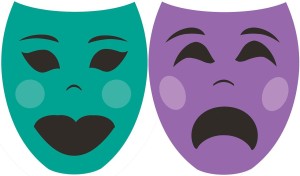
Who are Thalia and Melpomene?
Born in the 40s, I watched black and white movies. They had few special effects. Still, they offered top notch acting. Some of the movies were from the 20s. Some were older. These were the silents.
Silent Movies
To convey emotion, gestures and facial expressions were exaggerated. Today, this would be overacting.
Many scenes were filmed at a distance, but directors soon realized audiences wanted closeups of their favorite actors. Ancient Greeks used different means to gain audience engagement.
The Stage and Back to Greek Drama
In the 19th and early 20th century, entertainment featured live performances. The faces of actors were not readily seen.
Greek theater with its large audiences, used contorted facial masks. These conveyed specific emotions. By such means all could understood a performance.
Two of the masks are now iconic. The face of comedy and the face of tragedy. These two are associated with Greek mythological muses Thalia and Melpomene. The two masks now appear in wall hangings and decorative pins.
Thalia and Melpomene
Comedic Thalia is one of nine muses. They are associated with music, song and dance. Supposedly, they were fathered by Zeus. Thalia’s name (according to the Theoi web site) means ‘blooming, rich festivity’. Other renderings include ‘joyous, verdant’. Thalia grasps a comic mask in her hand. She may also hold a bugle.
Melpomene, means “choir.” She personifies tragedy. She carries in hand a tragic mask or sword. Both Thalia and Melpomene are adorned with ivy. The Shakespearean play Hamlet, played by tragedian Sarah Bernhardt, is reminiscent of Melpomene. Hamlet (Bernhardt in cross gender role) gazes at Yorick’s skull held at arm’s distance.
The Family
Sisters to Thalia and Melpomene are Calliope (eloquence), Clio (history), Erato (romantic love), Euterpe (song and dance), Polymnia (hymns), Terpsichore (choral song) and Urania (astronomy and astrological writings).
The mother of all nine is Mnemosyne. She is the daughter of Uranus (sky) and Gaia (earth). Zeus is the youngest son of Cronus and Rhea. They were also children of Uranus and Gaia.
Note: You might also like Thumbnail Mystery: Mike Rubino – Music to Die For
References:
- Break of Dawn Theater: The Story Behind the Comedy and Tragedy Masks
- Theoi: Thaleia
- Theoi: Melpomene
